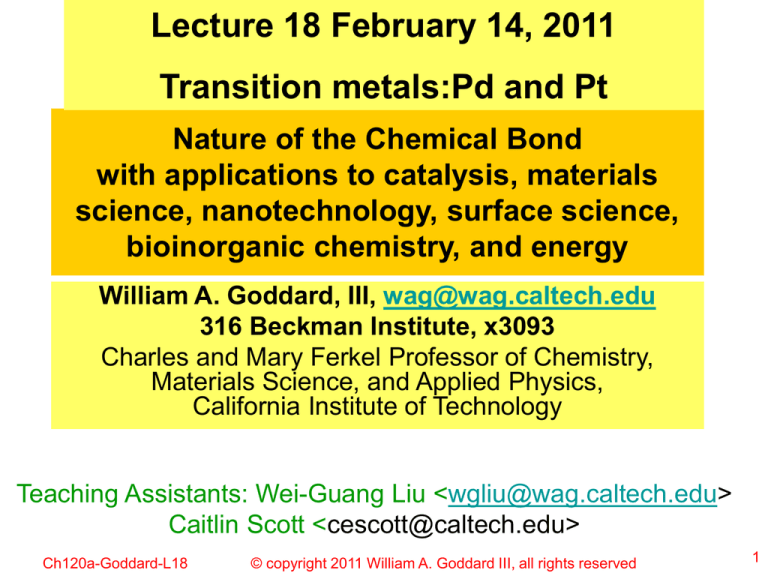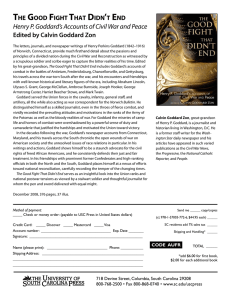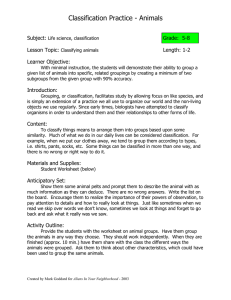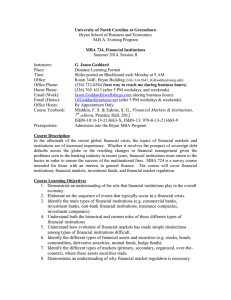
Lecture 18 February 14, 2011
Transition metals:Pd and Pt
Nature of the Chemical Bond
with applications to catalysis, materials
science, nanotechnology, surface science,
bioinorganic chemistry, and energy
William A. Goddard, III, wag@wag.caltech.edu
316 Beckman Institute, x3093
Charles and Mary Ferkel Professor of Chemistry,
Materials Science, and Applied Physics,
California Institute of Technology
Teaching Assistants: Wei-Guang Liu <wgliu@wag.caltech.edu>
Caitlin Scott <cescott@caltech.edu>
Ch120a-Goddard-L18
© copyright 2011 William A. Goddard III, all rights reserved
1
Last time
Ch120a-Goddard-L18
© copyright 2011 William A. Goddard III, all rights reserved
2
Transition metal atoms
Ch120a-Goddard-L18
© copyright 2011 William A. Goddard III, all rights reserved
3
Transition metals
Aufbau
(4s,3d) Sc---Cu
(5s,4d) Y-- Ag
(6s,5d) (La or Lu), Ce-Au
Ch120a-Goddard-L18
© copyright 2011 William A. Goddard III, all rights reserved
4
Transition metals
Ch120a-Goddard-L18
© copyright 2011 William A. Goddard III, all rights reserved
5
Ground states of neutral atoms
Sc
(4s)2(3d)1
Sc++
(3d)1
Ti
V
Cr
Mn
(4s)2(3d)2
(4s)2(3d)3
(4s)1(3d)5
(4s)2(3d)5
Ti ++
V ++
Cr ++
Mn ++
(3d)2
(3d)3
(3d)4
(3d)5
Fe
Co
Ni
(4s)2(3d)6
(4s)2(3d)7
(4s)2(3d)8
Fe ++
Co ++
Ni ++
(3d)6
(3d)7
(3d)8
Cu
(4s)1(3d)10
Cu++
(3d)10
Ch120a-Goddard-L18
© copyright 2011 William A. Goddard III, all rights reserved
6
The heme group
The net charge of the
Fe-heme is zero. The VB
structure shown is one of
several, all of which lead
to two neutral N and two
negative N.
Thus we consider that
the Fe is Fe2+ with a d6
configuration
Each N has a doubly
occupied sp2 s orbital
pointing at it.
Ch120a-Goddard-L18
© copyright 2011 William A. Goddard III, all rights reserved
7
Energies of the 5 Fe2+ d orbitals
x2-y2
z2=2z2-x2-y2
yz
xz
xy
Ch120a-Goddard-L18
© copyright 2011 William A. Goddard III, all rights reserved
8
Exchange stabilizations
Ch120a-Goddard-L18
© copyright 2011 William A. Goddard III, all rights reserved
9
Ferrous FeII
x2-y2 destabilized by
heme N lone pairs
z2 destabilized by
5th ligand imidazole
or 6th ligand CO
y
Ch120a-Goddard-L18
© copyright 2011 William A. Goddard III, all rights reserved
x
10
Summary 4 coord and 5 coord states
Ch120a-Goddard-L18
© copyright 2011 William A. Goddard III, all rights reserved
11
Out of plane motion of Fe – 4 coordinate
Ch120a-Goddard-L18
© copyright 2011 William A. Goddard III, all rights reserved
12
Add axial base
N-N Nonbonded
interactions push
Fe out of plane
is antibonding
Ch120a-Goddard-L18
© copyright 2011 William A. Goddard III, all rights reserved
13
Free atom to 4 coord to 5 coord
Net effect due to five N ligands is
to squish the q, t, and s states by
a factor of 3
Ch120a-Goddard-L18
This makes all three available as
possible ground states depending
14
onIII,the
6threserved
ligand
© copyright 2011 William A. Goddard
all rights
Bonding of O2 with O to form ozone
O2 has available a ps
orbital for a s bond to a
ps orbital of the O atom
And the 3 electron p
system for a p bond to a
pp orbital of the O atom
Ch120a-Goddard-L18
© copyright 2011 William A. Goddard III, all rights reserved
15
Bond O2 to Mb
Ch120a-Goddard-L18
Simple VB
structures
get S=1 or triplet
state
In fact MbO2 is
singlet
Why?
16
© copyright 2011 William A. Goddard III, all rights reserved
change in exchange terms when Bond O2 to Mb
O2ps
O2pp
Assume perfect 10 K
7 Kdd
dd
VB spin pairing
5*4/2 up spin 4*3/2
Then get 4 cases
+
Thus average Kdd is down spin 2*1/2
(10+7+7+6)/4 =7.5
Ch120a-Goddard-L18
7 Kdd
6 Kdd
4*3/2
+
2*1/2
3*2/2
+
3*2/2
© copyright 2011 William A. Goddard III, all rights reserved
17
Bonding O2 to Mb
Exchange loss
on bonding O2
Ch120a-Goddard-L18
© copyright 2011 William A. Goddard III, all rights reserved
18
Modified exchange energy for q state
But expected t binding to be 2*22 = 44 kcal/mol stronger than q
What happened?
Binding to q would have DH = -33 + 44 = + 11 kcal/mol
Instead the q state retains the
high spin pairing so that there is
no exchange loss, but now the
coupling of Fe to O2 does not gain
the full VB strength, leading to
bond of only 8kcal/mol instead of
33
Ch120a-Goddard-L18
© copyright 2011 William A. Goddard III, all rights reserved
19
Bond CO to Mb
H2O and N2 do not bond strongly enough to promote the Fe to
an excited state, thus get S=2
Ch120a-Goddard-L18
© copyright 2011 William A. Goddard III, all rights reserved
20
compare bonding of CO and O2 to Mb
Ch120a-Goddard-L18
© copyright 2011 William A. Goddard III, all rights reserved
21
GVB orbitals for bonds to Ti
Ti ds character, 1 elect
H 1s character, 1 elect
Covalent 2 electron
TiH bond in Cl2TiH2
Think of as bond
from Tidz2 to H1s
Csp3 character 1 elect
H 1s character, 1 elect
Covalent 2 electron
CH bond in CH4
Ch120a-Goddard-L18
© copyright 2011 William A. Goddard III, all rights reserved
22
Bonding at a transition metaal
Bonding to a transition metals can be quite covalent.
Examples: (Cl2)Ti(H2), (Cl2)Ti(C3H6), Cl2Ti=CH2
Here the two bonds to Cl remove ~ 1 to 2 electrons from the Ti,
making is very unwilling to transfer more charge, certainly not
to C or H (it would be the same for a Cp (cyclopentadienyl
ligand)
Thus TiCl2 group has ~ same electronegativity as H or CH3
The covalent bond can be thought of as Ti(dz2-4s) hybrid spin
paired with H1s
A{[(Tids)(H1s)+ (H1s)(Tids)](ab-ba)}
Ch120a-Goddard-L18
© copyright 2011 William A. Goddard III, all rights reserved
23
But TM-H bond can also be s-like
Cl2TiH+
Ti (4s)2(3d)2
The 2 Cl pull off 2 e from
Ti, leaving a d1
configuration
Ti-H bond character
1.07 Tid+0.22Tisp+0.71H
ClMnH
Mn (4s)2(3d)5
The Cl pulls off 1 e from
Mn, leaving a d5s1
configuration
H bonds to 4s because
of exchange stabilization
of d5
Mn-H bond character
0.07Ch120a-Goddard-L18
Mnd+0.71Mnsp+1.20H
© copyright 2011 William A. Goddard III, all rights reserved
24
Bond angle at a transition metal
For two p orbitals expect 90°, HH nonbond repulsion increases it
What angle do two
d orbitals want
H-Ti-H plane
76°
Ch120a-Goddard-L18
Metallacycle plane
© copyright 2011 William A. Goddard III, all rights reserved
25
Best bond angle for 2 pure Metal bonds using d orbitals
Assume that the first bond has pure dz2 or ds character to a ligand
along the z axis
Can we make a 2nd bond, also of pure ds character (rotationally
symmetric about the z axis) to a ligand along some other axis, call
it z.
For pure p systems, this leads to = 90°
For pure d systems, this leads to = 54.7° (or 125.3°), this is ½
the tetrahedral angle of 109.7 (also the magic spinning angle for
solid state NMR).
Ch120a-Goddard-L18
© copyright 2011 William A. Goddard III, all rights reserved
26
Best bond angle for 2 pure Metal bonds using d orbitals
Problem: two electrons in atomic d orbitals with same spin lead to
5*4/2 = 10 states, which partition into a 3F state (7) and a 3P state
(3), with 3F lower. This is because the electron repulsion between
say a dxy and dx2-y2 is higher than between sasy dz2 and dxy.
Best is ds with dd because the electrons are farthest apart
This favors = 90°, but the bond to the dd orbital is not as good
Thus expect something between 53.7 and 90°
Seems that ~76° is often best
Ch120a-Goddard-L18
© copyright 2011 William A. Goddard III, all rights reserved
27
How predict character of Transition metal bonds?
Start with ground state atomic configuration
Ti (4s)2(3d)2 or Mn (4s)2(3d)5
Consider that bonds to electronegative ligands (eg Cl or Cp)
take electrons from 4s
easiest to ionize, also better overlap with Cl or Cp, also leads
to less reduction in dd exchange
(3d)2
(4s)(3d)5
Now make bond to less electronegative ligands, H or CH3
Use 4s if available, otherwise use d orbitals
Ch120a-Goddard-L18
© copyright 2011 William A. Goddard III, all rights reserved
28
But TM-H bond can also be s-like
Cl2TiH+
Ti (4s)2(3d)2
The 2 Cl pull off 2 e from
Ti, leaving a d1
configuration
Ti-H bond character
1.07 Tid+0.22Tisp+0.71H
ClMnH
Mn (4s)2(3d)5
The Cl pulls off 1 e from
Mn, leaving a d5s1
configuration
H bonds to 4s because
of exchange stabilization
of d5
Mn-H bond character
0.07Ch120a-Goddard-L18
Mnd+0.71Mnsp+1.20H
© copyright 2011 William A. Goddard III, all rights reserved
29
Example (Cl)2VH3
+ resonance
configuration
Ch120a-Goddard-L18
© copyright 2011 William A. Goddard III, all rights reserved
30
Example ClMometallacycle
butadiene
Ch120a-Goddard-L18
© copyright 2011 William A. Goddard III, all rights reserved
31
Example [Mn≡CH]2+
Ch120a-Goddard-L18
© copyright 2011 William A. Goddard III, all rights reserved
32
Summary:
start with Mn+ s1d5
dy2 s bond to H1s
dx2-x2 non bonding
dyz p bond to CH
dxz p bond to CH
dxy non bonding
4sp hybrid s bond to CH
Ch120a-Goddard-L18
© copyright 2011 William A. Goddard III, all rights reserved
33
Summary:
start with Mn+ s1d5
dy2 s bond to H1s
dx2-x2 non bonding
dyz p bond to CH
dxz p bond to CH
dxy non bonding
4sp hybrid s bond to CH
Ch120a-Goddard-L18
© copyright 2011 William A. Goddard III, all rights reserved
34
new
Ch120a-Goddard-L18
© copyright 2011 William A. Goddard III, all rights reserved
35
Compare chemistry of column 10
Ch120a-Goddard-L18
© copyright 2011 William A. Goddard III, all rights reserved
36
Ground state of group 10 column
Pt: (5d)9(6s)1 3D ground state
Pt: (5d)10(6s)0 1S excited state at 11.0 kcal/mol
Pt: (5d)8(6s)2 3F excited state at 14.7 kcal/mol
Ni: (5d)8(6s)2 3F ground state
Ni: (5d)9(6s)1 3D excited state at
0.7 kcal/mol
Ni: (5d)10(6s)0 1S excited state
at 40.0 kcal/mol
Pd: (5d)10(6s)0 1S ground state
Pd: (5d)9(6s)1 3D excited state at 21.9 kcal/mol
Pd:Ch120a-Goddard-L18
(5d)8(6s)2 3F excited
state
atWilliam
77.9A. Goddard
kcal/mol
© copyright
2011
III, all rights reserved
37
Salient differences between Ni, Pd, Pt
2nd row (Pd): 4d much more stable than 5s Pd d10 ground state
3rd row (Pt): 5d and 6s comparable stability Pt d9s1 ground state
Ch120a-Goddard-L18
© copyright 2011 William A. Goddard III, all rights reserved
38
Ground state configurations for column 10
Ni
Ch120a-Goddard-L18
Pd
© copyright 2011 William A. Goddard III, all rights reserved
Pt
39
Mysteries from experiments on oxidative addition and reductive
elimination of CH and CC bonds on Pd and Pt
Why are Pd and Pt so
different
Ch120a-Goddard-L18
© copyright 2011 William A. Goddard III, all rights reserved
40
Mysteries from experiments on oxidative addition and reductive
elimination of CH and CC bonds on Pd and Pt
Why is CC coupling
so much harder than CH coupling?
© copyright 2011 William A. Goddard III, all rights reserved
Ch120a-Goddard-L18
41
Step 1: examine GVB orbitals for (PH3)2Pt(CH3)
Ch120a-Goddard-L18
© copyright 2011 William A. Goddard III, all rights reserved
42
Analysis of GVB wavefunction
Ch120a-Goddard-L18
© copyright 2011 William A. Goddard III, all rights reserved
43
Alternative models for Pt centers
Ch120a-Goddard-L18
© copyright 2011 William A. Goddard III, all rights reserved
44
Ch120a-Goddard-L18
© copyright 2011 William A. Goddard III, all rights reserved
45
Ch120a-Goddard-L18
© copyright 2011 William A. Goddard III, all rights reserved
46
energetics
Ch120a-Goddard-L18
Not agree with
experiment 47
© copyright 2011 William A. Goddard III, all rights reserved
Possible explanation: kinetics
Ch120a-Goddard-L18
© copyright 2011 William A. Goddard III, all rights reserved
48
Consider reductive elimination of HH,
CH and CC from Pd
Conclusion:
HH no barrier
CH modest barrier
CC large barrier
Ch120a-Goddard-L18
© copyright 2011 William A. Goddard III, all rights reserved
49
Consider oxidative addition of
HH, CH, and CC to Pt
Ch120a-Goddard-L18
Conclusion:
HH no barrier
CH modest barrier
CCreserved
large barrier 50
© copyright 2011 William A. Goddard III, all rights
Summary of barriers
This explains why CC coupling not occur for Pt while CH
and HHcoupling is fast
But why?
Ch120a-Goddard-L18
© copyright 2011 William A. Goddard III, all rights reserved
51
How estimate the size of barriers (without calculations)
Ch120a-Goddard-L18
© copyright 2011 William A. Goddard III, all rights reserved
52
Examine HH coupling at transition state
Can simultaneously get good overlap of H with Pd sd
hybrid and with the other H
Thus get resonance stabilization of TS low barrier
Ch120a-Goddard-L18
© copyright 2011 William A. Goddard III, all rights reserved
53
Examine CC coupling at transition state
Can orient the CH3 to obtain good overlap with Pd sd hybrid OR
can orient the CH3 to obtain get good overlap with the other CH3
But CANNOT DO BOTH SIMULTANEOUSLY, thus do NOT get
54
resonance© stabilization
ofA. TS
III,high
barier
Ch120a-Goddard-L18
copyright 2011 William
Goddard
all rights
reserved
Examine CH coupling at transition state
Ch120a-Goddard-L18
H can overlap
both CH3 and Pd
sd hybrid
simultaneously
but CH3 cannot
thus get ~ ½
resonance
stabilization of TS
55
© copyright 2011 William A. Goddard III, all rights reserved
Now we understand Pt chemistry
But what about Pd?
Why are Pt and Pd so
dramatically different
Ch120a-Goddard-L18
© copyright 2011 William A. Goddard III, all rights reserved
56
stop
Ch120a-Goddard-L18
© copyright 2011 William A. Goddard III, all rights reserved
57




